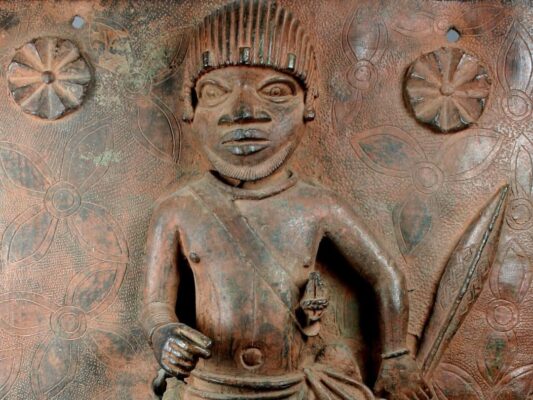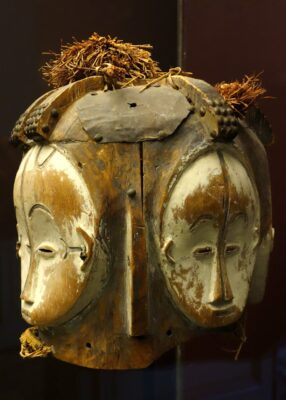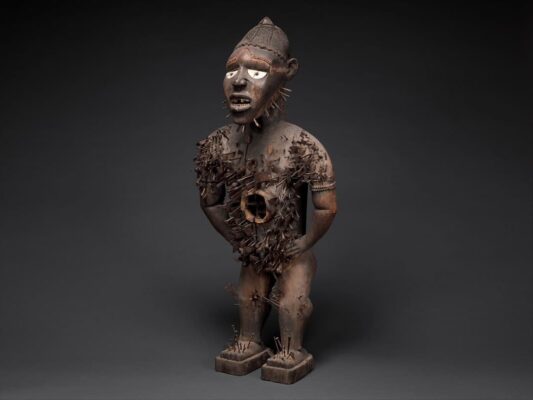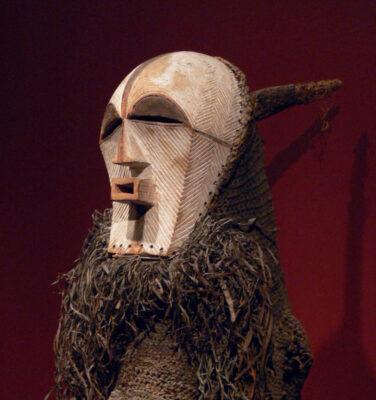Arte Africano
Rostros de Poder y Sabiduría
«Las máscaras [africanas] no eran simples esculturas como las demás. En absoluto. Eran objetos mágicos… Eran armas. Para ayudar a la gente a dejar de ser gobernada por los espíritus, a liberarse. Herramientas. Si damos una forma a esos espíritus, nos liberamos… Entendí por qué me hice pintor. ‘Les Demoiselles d’Avignon’ debió de nacer en mí ese mismo día, pero no por las formas, sino porque fue mi primer cuadro de ‘exorcismo’»
Pablo Picasso, recordando su primera visita al Museo Etnográfico del Trocadero de París
Imágenes: Benín. Placa de latón que representa a un funcionario judicial. Anteriormente en el Museo Metropolitano, devuelta a Nigeria en 2021. Imagen por cortesía del Metropolitan Museum of Art, Nueva York ·· Pueblo fang, máscara con casco Ngontang con cuatro caras, Royal Museum for Central Africa ·· Congo, Figura de poder (Nkisi N’Kondi: Mangaaka), Metropolitan Museum of Art ·· Máscara Kifwebe, Dallas Museum of Art
Por lo general, se entiende por arte africano a toda forma de arte producida en el África subsahariana a lo largo de la historia. En este sentido, si bien el arte del Antiguo Egipto es, al menos desde el punto de vista geográfico, enteramente africano, su cultura y marco temporal es muy distinto a la de las culturas que del África subsahariana, y en esta página se aborda en una entrada independiente. La misma estrategia se ha seguido con el arte islámico creado en el norte de África.
El principal aspecto al tener en cuenta al estudiar el arte africano es la enorme cantidad de culturas existentes. Sirva como ejemplo el hecho de que el número de idiomas hablados en el continente se calcula entre 1000 y 2000 (“Introduction to African Languages”, Universidad de Harvard), con 250 de ellos hablados en el territorio de la actual Nigeria. Por lo general, estamos hablando de comunidades culturales de tamaño más bien pequeño, con un gran sentido de la vida en comunidad, que otorgan una gran importancia al clan, y un gran respeto a los antepasados. Dentro de estas unidades culturales, el arte sirve como refuerzo y celebración de la comunidad. Así, “el escultor no era un individuo que expresaba sus sentimientos personales (…) sino que el arte que producía pretendía satisfacer las necesidades de una comunidad en la que estaba muy integrado. (…) Es frecuente que la pauta establecida para las formas tuviera significación únicamente para la comunidad que la generaba (…), Así pues, el arte constituía una fuerza unificadora dentro de la comunidad, puesto que reafirmaba la identidad comunitaria al servirse de un lenguaje específico” (Jocelyn Murray, Instituto Africano de Londres: “Atlas Culturales del Mundo: África”, 1992.)
Resulta muy difícil establecer algún tipo de clasificación o agrupación en el arte del África subsahariana. Algunas divisiones geográficas propuestas (África oriental, Sur del Río Congo, etc.), aunque puedan resultar prácticas a la hora de estudiar las culturas de forma individual, resultan bastante arbitrarias. Por lo general, el arte tradicional africano empleó la madera como material base, realizando obras escultóricas de pequeño y mediano tamaño, en especial máscaras y figuras rituales. En algunos casos, se emplea pelo de animal, piedras semipreciosas u otros objetos con sentido estético o expresivo.
Existen, por supuesto, casos particulares muy notables dentro del arte africano. Uno de ellos son los Bronces de Benin, un conjunto de más de mil placas y esculturas de metal, generalmente bronce o latón, de estilo mucho más naturalista que otras obras de arte del continente, como las de la cultura Fang o Senufo; y que llamaron la atención de los primeros exploradores europeos, siendo alabados en el libro “Descripción de África” publicado en 1668 por Olfert Dapper. En el caso de Etiopía, la temprana e intensa influencia cristiana llevó a crear obras de arte y arquitectura muy distintas a las de zona vecinas.
El arte africano tuvo una influencia colosal en las vanguardias del arte europeo de principios del siglo XX. Como se indica en la cita que da comienzo a este ensayo, Picasso reconoció su deuda con el arte africano antes de su Periodo Cubista, y la influencia de las máscaras africanas es evidente en artistas como Matisse y Modigliani. Tras el fin de la era colonial, el interés por el arte contemporáneo africano ha ido aumentando, realizándose exposiciones en los principales museos del mundo, y con artistas como El Anatsui, cuyo arte se basa en la tradición de su Ghana natal, logrando el interés de grandes coleccionistas.
G. Fernández · theartwolf.com
Follow us on:




